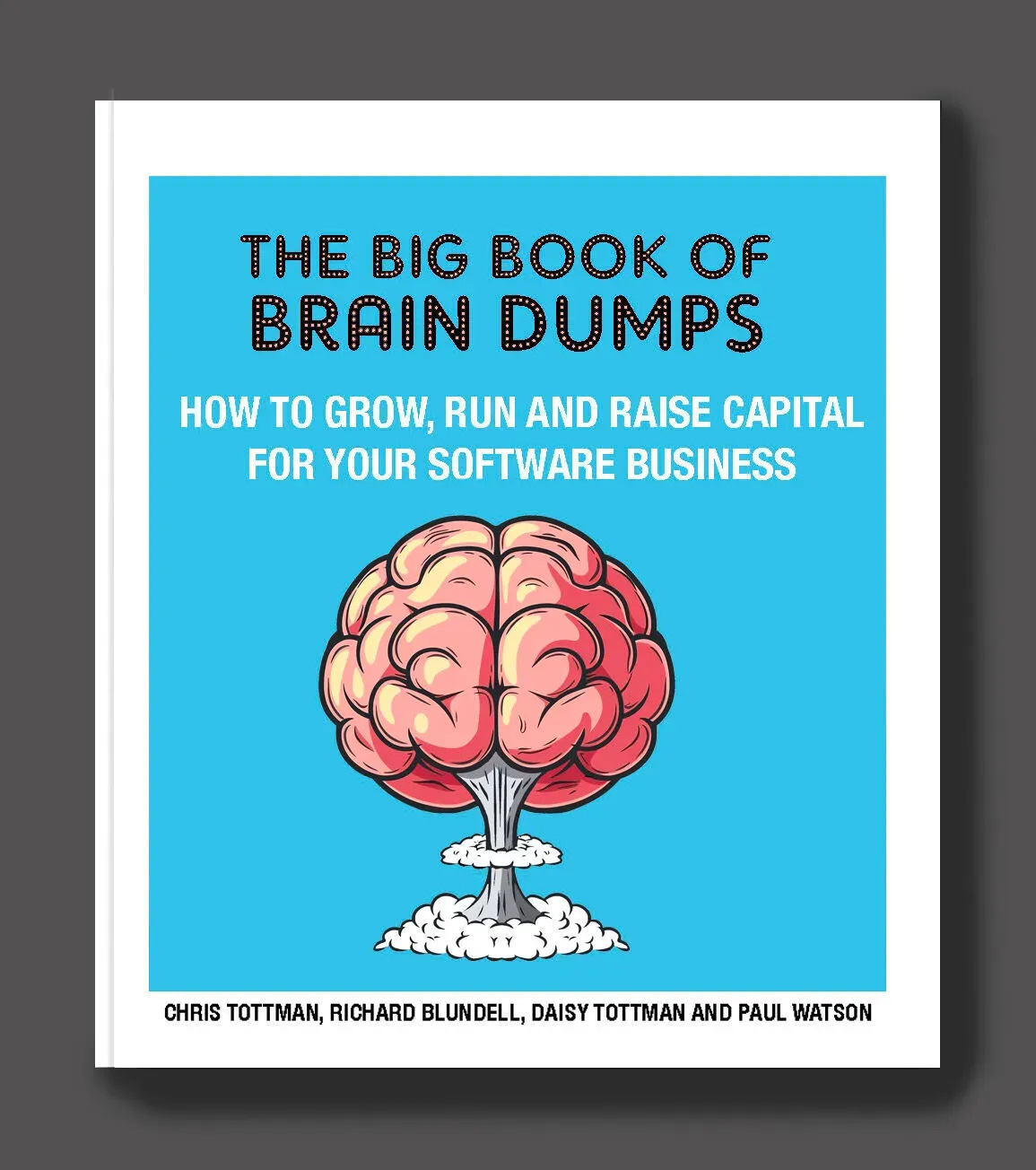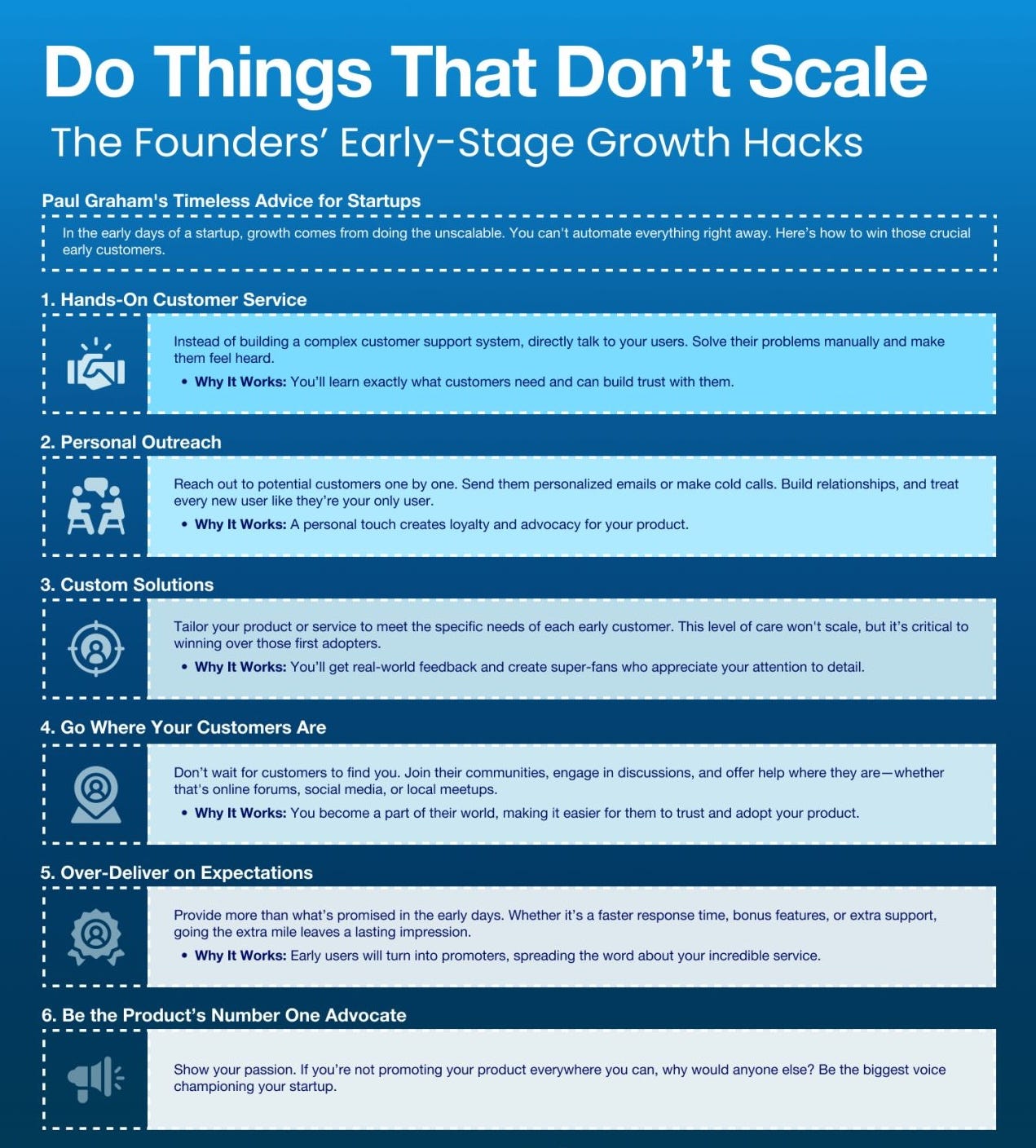💥 Early-Stage Growth Hacks: Do Things That Don’t Scale
It sounds counter-intuitive. Yet, Airbnb almost died without it. Here's why:
👋 Hey, Chris here! Welcome to BrainDumps—a weekly series from The Founders Corner. If you’ve been reading along, you know this series is a preview of a bigger project. Well, it’s finally here: The Big Book of BrainDumps is out now!
It isn’t a theory book—it’s the founder’s field manual. Inside, you’ll find 70 powerful frameworks distilled from 30+ years scaling software companies to hundreds of millions in ARR, 20+ years investing in 500+ B2B tech startups, and over $1B of shareholder value created. From raising capital to hiring your first VP of Sales, this book turns scars and successes into practical playbooks you’ll return to again and again. I expect most copies will become well-worn, scribbled on, and dog-eared—because it works.
The Airbnb Story That Changed Everything
In the early days of Airbnb, Brian Chesky and Joe Gebbia noticed something odd. Their listings weren’t converting. They had traffic. They had hosts. But guests weren’t booking.
Why?
The photos were terrible.
Most hosts had uploaded low-quality, amateur images. Properties looked dull. Small. Uninspiring. So Chesky and Gebbia picked up a camera, flew to New York, and started knocking on doors.
They didn’t outsource it. They didn’t hire a freelancer.
They did it themselves.
They visited hosts in person, took professional-grade photos of each property, and uploaded them manually to the site.
This was the very definition of “unscalable.”
But the results were staggering.
Listings with pro photos started getting booked.
Weekly revenue doubled—from $200 to $400.
And, perhaps most importantly, trust grew.
They didn’t just fix a UX issue—they built credibility.
Later, Airbnb scaled that process. They created a photography network. Built tools. Optimised workflows.
But it started with a camera, two founders, and a handful of listings.
And that’s what this article is about.
Table of Contents
Why Doing the Unscalable Is Your Secret Weapon
Hands-On Customer Service
Personal Outreach
Custom Solutions
Go Where Your Customers Are
Over-Deliver on Expectations
Be the Product’s Number One Advocate
Why Founders Avoid This Work
When to Automate? Later.
Final Thought: Scale Starts With Sweat
1. Why Doing the Unscalable Is Your Secret Weapon
Every founder wants to grow fast. But speed without signal is chaos.
You can’t automate insight. You can’t outsource learning.
In the early days, your job isn’t to scale. Your job is to understand—to be close enough to your customers that you hear their friction before it turns into churn.
Paul Graham said it best:
“Do things that don’t scale.”
This is not a temporary sacrifice. It’s a permanent advantage.
Because the things that don’t scale are often the very things that give you traction.
Let me show you the moves that I’ve seen power some of the most successful SaaS founders in Europe.
2. Hands-On Customer Service
One founder I backed personally replied to every single support ticket—himself—for the first 500 users.
He didn’t just fix issues. He got on Zoom calls. Sent Looms. Followed up days later to see how users were getting on. And when someone churned? He asked why, in detail.
This didn’t scale.
But it did something better: it rewrote their roadmap in real time.
Lesson: Every complaint is a feature request in disguise—if you’re willing to hear it.
3. Personal Outreach
I know a founder who built their first 100 users purely through LinkedIn DMs.
No campaign manager. No email tool. No SDRs.
Just a list, a clear ICP, and personalised, relevant messages. She didn’t pitch hard—she asked questions. Listened. Followed up. Closed.
That early user base became her first 10 advocates. They brought their peers. Introduced her to communities. Backed her roadmap.
Lesson: Early-stage growth is hand-to-hand combat. Make it personal.
4. Custom Solutions
One startup I worked with said “yes” to nearly every strange customer request in their first three months. Manual data exports. Feature toggles. Workflow tweaks.
It looked messy. But what came out of that phase?
Their first big insight: what customers really valued wasn't flexibility—it was speed. Every “yes” revealed a deeper pattern.
Six months later, those “custom” solutions were productized into a slick, intuitive onboarding flow—and became their core differentiator.
Lesson: When you say yes manually, you're not scaling chaos. You’re gathering insight.
5. Go Where Your Customers Are
One founder embedded herself inside a private Slack group of 500 marketers.
She never pitched. She helped.
Answered questions. Gave feedback. Shared early ideas. After a few weeks, people started asking what she was building. When she finally shared her beta, 70 people signed up within 48 hours.
That community is now her #1 source of organic referrals.
Lesson: If you're not in the room where your customers hang out, someone else is earning their trust.
6. Over-Deliver on Expectations
Delight is the most underrated growth channel.
One SaaS founder I mentored onboarded every customer personally via Zoom. But he didn’t stop there. After the call, he’d send a custom training video tailored to their use case—recorded that same day.
Users were blown away. Not just because of the feature set, but because someone actually cared.
Result? Their NPS was 70+ before they ever spent a dollar on paid ads.
Lesson: You don’t need to add features. You need to add moments people will remember.
7. Be the Product’s Number One Advocate
Founders often underestimate the power of their own voice.
I worked with a deeply technical CTO-type founder who wasn’t keen on being public-facing. But I pushed him to write a short post about his product journey on LinkedIn. Then another. Then a demo video.
Suddenly, developers were DMing him. People wanted in.
Your early users want to believe they’re buying into something real. Your conviction creates that. Your energy scales before your code does.
Lesson: If you won’t talk about your product with energy, why should anyone else?
8. Why Founders Avoid This Work
Because it’s messy.
It’s manual.
And—on the surface—it’s inefficient.
But here’s what I tell every founder:
“You don’t scale by skipping the hard stuff. You scale by learning what works—then codifying it.”
If you try to build a repeatable motion without ever getting in the trenches, your system will be built on assumptions.
The founders who stay close to the action?
They build reality-based businesses.
9. When to Automate? Later.
Here’s what’s beautiful about doing the work yourself first:
You learn what actually matters to customers
You see which objections come up again and again
You find out where your value really lands
Then, and only then, do you automate:
Your onboarding sequence
Your outreach motion
Your support flows
Your marketing ops
By then, you're not guessing. You're scaling something that’s already working.
10. Final Thought: Scale Starts With Sweat
Let’s bring it back to Airbnb.
Two founders. A camera. A city of hosts.
They could’ve waited. Hired someone. Built a tool.
Instead, they got on planes and did the work.
They didn’t just fix a conversion funnel—they changed the trajectory of their company.
If you’re reading this and you’re in the early days of your startup—under 100 customers, pre-product/market fit—here’s what I want you to remember:
You don’t need to grow fast.
You need to grow smart.
And that starts with unscalable moves.
So:
Talk to your users
Answer their questions
Write the emails
Do the calls
Say yes
Ship it by hand
Show up where they are
Do the work.
Because the work builds the company.
And eventually, the company builds the scale.
—Chris Tottman




All this examples highlight the importance of having first hand experience with the problem you are trying to solve, there is a level of insight that can only happen there. I would argue that getting that “proprietary insight” can become your most important differentiation
Great one!